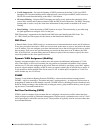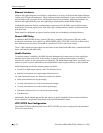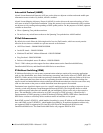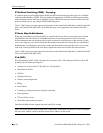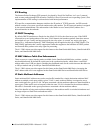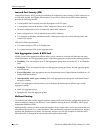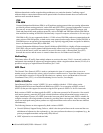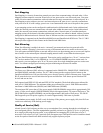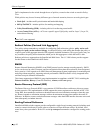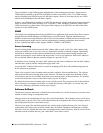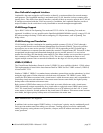
Software Supported
OmniSwitch 6800/6850/9000—Release 6.1.3.R01 page 29
Port Mapping
Port Mapping is a security feature that controls peer users from communicating with each other. A Port
Mapping session comprises a session ID and a set of user ports and/or a set of network ports. User ports
within a session cannot communicate with each other and can only communicate via network ports. In a
Port Mapping session with user port set A and network port set B, ports in set A can only communicate
with ports in set B. If set B is empty, ports in set A can communicate with rest of the ports in the system.
A port mapping session can be configured in unidirectional or bidirectional mode. In the unidirectional
mode, the network ports can communicate with each other within the same session. In the bidirectional
mode, the network ports cannot communicate with each other. Network ports of a unidirectional port
mapping session can be shared with other unidirectional sessions, but cannot be shared with any sessions
configured in bidirectional mode. Network Ports of different sessions can communicate with each other.
Port Mapping is supported on the OmniSwitch 6800 Series and OmniSwitch 6850 Series. The 6.1.3.R01
release provides support for this feature on the OmniSwitch 9000 Series.
Port Mirroring
When Port Mirroring is enabled, the active “mirrored” port transmits and receives network traffic
normally, and the “mirroring” port receives a copy of all transmit and receive traffic to the active port.
You can connect an RMON probe or network analysis device to the mirroring port to see an exact duplica-
tion of traffic on the mirrored port without disrupting network traffic to and from the mirrored port.
Only one Port Mirroring session is supported. That session can be configured to a “N-to-1” session where
“N” can be a number from 1 to 24 (OS6800) or 1 to 128 (OS6850/OS9000) anywhere on the stack. In
other words, you can configure up to 24 or 128 source ports for a single destination port in a session on a
stack. You cannot configure port mirroring and port monitoring on the same NI module.
Power over Ethernet (PoE)
The Power over Ethernet (PoE) software is supported on the OS6850-P24, OS6850-P24X, OS6850-P48,
and OS6850-P48X stackable switches. The 6.1.3.R01 release provides support for this feature on the
OmniSwitch 9000 Series. PoE provides inline power directly from the switch’s Ethernet ports. From these
RJ-45 ports the devices receive both electrical power and data flow. PoE detects power based on PSE
devices and not on class.
PoE supports both IEEE 802.3af and non-IEEE 802.3af standards. The default inline power allotted for
each port is 15400 Milliwatts. The minimum inline power allotted for a port is 3000 Milliwatts and the
maximum is 16000 Milliwatts (OS6850) and 18000 Milliwatts (OS9000).
The maximum PoE power that a 510w power-supply (OS6850/OS9600) can provide is approximately 380
watts. A 360w power-supply (OS6850/OS9600) can provide approximately 230 watts of PoE power. The
OS-IP-Shelf power supplies (OS9000) can provide approximately 600 watts of PoE power. The OS-IP-
Shelf supports up to four power supplies, so a total of approximately 2400 watts is possible.
The redundant power supply for PoE is only for backup. If the primary power supply fails, then PoE can
switch over seamlessly to the backup power supply.
Quality of Service (QoS)
Alcatel-Lucent’s QoS software provides a way to manipulate flows coming through the switch based on
user-configured policies. The flow manipulation (generally referred to as Quality of Service or QoS) may
be as simple as allowing/denying traffic, or as complicated as remapping 802.1p bits from a Layer 2
network to ToS values in a Layer 3 network. QoS can support up to 2048 policies and it is hardware-based
on the first packet. OmniSwitch 9000 switches truly support 8 queues per port.



